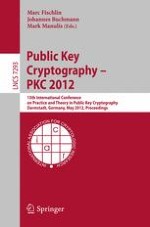2012 | OriginalPaper | Buchkapitel
Multi-location Leakage Resilient Cryptography
verfasst von : Ali Juma, Yevgeniy Vahlis, Moti Yung
Erschienen in: Public Key Cryptography – PKC 2012
Verlag: Springer Berlin Heidelberg
Aktivieren Sie unsere intelligente Suche, um passende Fachinhalte oder Patente zu finden.
Wählen Sie Textabschnitte aus um mit Künstlicher Intelligenz passenden Patente zu finden. powered by
Markieren Sie Textabschnitte, um KI-gestützt weitere passende Inhalte zu finden. powered by
Understanding and modeling leakage in the context of cryptographic systems (connecting physical protection of keys and cryptographic operation) is an emerging area with many missing issues and hard to understand aspects. In this work we initiate the study of leakage out of cryptographic devices when the operation is inherently replicated in
multiple locations
. This setting (allowing the adversary access to leakage at different locations) arises naturally in cases like protocols, where different parties activate the same cryptographic function, or in the case of a global service providers (like cloud operators) which need to replicate the cryptographic function to allow for accessible and responsive services. We specifically deal with the theoretical setting of “leakage resilient cryptography,” (modeling leakage as a bound associated with algorithmic steps), and in the most general model of continual leakage on memory, randomness (and thus computation) with periods of operation and refresh of private keys between them.
We first investigate public-key cryptography, and construct a multi-location leakage resilient signature scheme (with unbounded number of locations) with optimal (i.e., total
n
(1 −
o
(1)) leakage) in a period, and
O
(log
n
) leakage during updates (
n
is the key size). The new crucial issue behind our scheme is how to maintain leakage at each location at the level of key leakage in the single location variant, even under parallel adaptive leakage at the different locations. We then construct a shared-symmetric-key authenticated session protocol that is resilient to leakage on both the sender and the receiver, and tolerates
O
(log
n
) bits of leakage per computation. We construct and utilize a single-location pseudorandom generator which is the first to tolerate continual leakage with only an efficient pseudorandom function as a primitive component. This protocol highlights the importance of protocol level “per message synchronization” against leakage adversaries. Interestingly, the construction is secure in spite of the entire randomness used in the refresh processes being publicly available.
